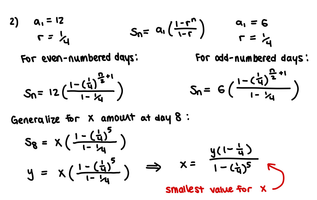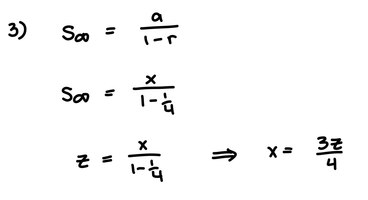Kristina123
New member
- Joined
- Nov 11, 2019
- Messages
- 42
You can just replace 12 in your work with x, and see what happens. First, though, observe what are the lowest and highest amounts of the drug at any given time in the initial scenario, to get a better idea of what the other parts are asking.
You can just replace 12 in your work with x, and see what happens. First, though, observe what are the lowest and highest amounts of the drug at any given time in the initial scenario, to get a better idea of what the other parts are asking.
Do you know anything about geometric series? If so, that can make things easier.
If not, please tell us what you have been learning that this exercise might be intended to exercise?
I have been learning convergence and divergence tests which involve series and sigma but I haven't had enough practice to fully master it, and my understanding of this topic is very poor at the moment. For now, I was able to notice a pattern in the denominator - the power raised increases by 1 each term. In the numerator, however, I noticed that the numerator in the next term is produced by multiplying the previous by 4 and adding 1. I have no idea how to generalize this into a formula for a geometric series, if it is even considered one.0......1........................2.........................3......................4
x.....x/2...........x/4 +x =5/4x.........5/8x..........5/16x+x=21/6x

I'm sure there are several very different ways to solve this; yours is largely guessing, but that could lead to a testable answer.I have been learning convergence and divergence tests which involve series and sigma but I haven't had enough practice to fully master it, and my understanding of this topic is very poor at the moment. For now, I was able to notice a pattern in the denominator - the power raised increases by 1 each term. In the numerator, however, I noticed that the numerator in the next term is produced by multiplying the previous by 4 and adding 1. I have no idea how to generalize this into a formula for a geometric series, if it is even considered one.
For 3), would z be 16? It seems that the highest amounts of the drug approach 16. And for 2), would y be 16? If these values are correct, I'm not sure how to find x such that it is the smallest value, or largest value
View attachment 35364
There is no way your answers can be correct--sorry.For 3), would z be 16? It seems that the highest amounts of the drug approach 16. And for 2), would y be 16? If these values are correct, I'm not sure how to find x such that it is the smallest value, or largest value
I'm sure there are several very different ways to solve this; yours is largely guessing, but that could lead to a testable answer.
My idea was to focus not on the totals for each day, but on the terms that go into each:
Do you see a geometric series in each column?
Also, observe that even and odd days work differently, so you might want to find a formula for even days first, and then work out odd days from that.
As for the questions about y and z, you need, first, to recognize that you are not asked for y and z; they are supposed to be given to you. You are asked for values of x that will produce the desired results. And you can answer them using (in part) the formulas in x that you have shown.
Lets look at the different numerators
1 5 21 85 and 341. Do you see a pattern? I do.
There is no way your answers can be correct--sorry.
The reason is that for problem 2 and 3 they are asking for x, NOT y or z.
y and z are fixed and can be ANY positive number. That is, you can't find y or z. I guess that your answer for x will depend on y. Possible the answer might look like x = 3y -5

You don't want the drug to exceed z for any time period. The time is from start until forever. Does that help you?However, for 3) I'm not given a specific day so it seems like I don't have a constraint to limit the amount of drug to administer. How do I solve 3)?
Oh so I would have to put z instead of y, and plug in n = infinity and determine what it converges to?You don't want the drug to exceed z for any time period. The time is from start until forever. Does that help you?
I see the pattern of 4 times the previous number plus 1 to get the next. I attempted 3) by using the infinite geometric series formula - I'm not sure if this is correct though.For the numerators-- 1, 5, 21, 85, 341--there is a pattern. Look at the differences between any two consecutive numbers. That should be helpful.

I think the answer should be x=2y(1-1/4)/(1-(1/4)^5)Hi, I think I'm slowly starting to understand - it's feels so exciting to make some progress. I solved 2) using the geometric series formula and the numbers seem right when I plug in n = 8 for day 8. I did some algebra and I'm confident that this is the smallest x I'm looking for? However, for 3) I'm not given a specific day so it seems like I don't have a constraint to limit the amount of drug to administer. How do I solve 3)?
View attachment 35372
Sorry, I'm not understanding where the 2 is coming from. Could you explain why there is a 2?I think the answer should be x=2y(1-1/4)/(1-(1/4)^5)
If I'm not mistaken you lost another 2. I get that x = 3z/2I see the pattern of 4 times the previous number plus 1 to get the next. I attempted 3) by using the infinite geometric series formula - I'm not sure if this is correct though.
View attachment 35373
Nope. Please look over all your work and you'll find it. Please try.Sorry, I'm not understanding where the 2 is coming from. Could you explain why there is a 2?
Almost. For odd days, I think you meant to use (n-1)/2 + 1 as the exponent, since you have to subtract 1 from n to make it divisible by 2. (You want half of the value on the day before.) And plugging in n=9 to the corrected version, I get what you found at first, 7.9921875.Hi, I think I'm slowly starting to understand - it's feels so exciting to make some progress.
Let's check it. Suppose the amount you want at day 8 is what you showed for part 1, 15.984375. The formula then gives [math]x=\frac{15.984375(0.75)}{1-0.0009765625}=12[/math]I solved 2) using the geometric series formula and the numbers seem right when I plug in n = 8 for day 8. I did some algebra and I'm confident that this is the smallest x I'm looking for?
This problem has a rather different goal: You want to find the highest level ever, and make sure that is not greater than z.However, for 3) I'm not given a specific day so it seems like I don't have a constraint to limit the amount of drug to administer. How do I solve 3)?
You're taking the infinite case of your formulaI attempted 3) by using the infinite geometric series formula - I'm not sure if this is correct though.
